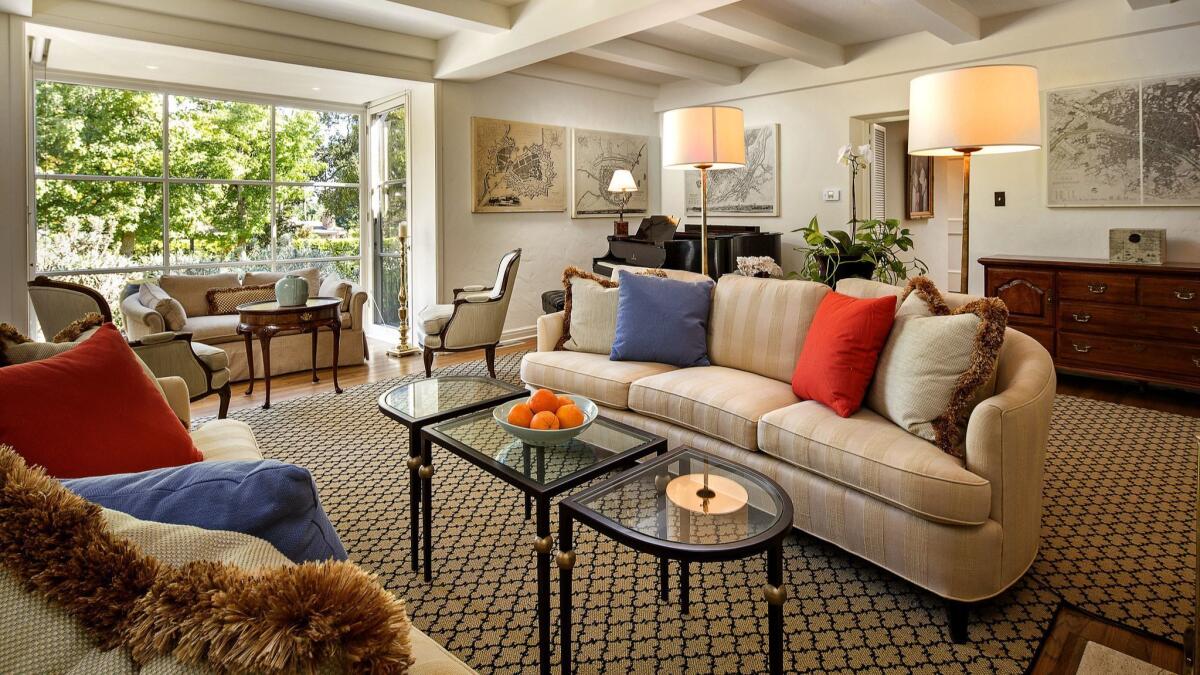Big Carpet wants to end America’s love of hardwood floors

- Share via
After presiding over 18 months of research and development, Keith Weinberger says he has finally found the “generational change” needed to revive an industry two decades past its peak. “This will blow your mind,” he said. Weinberger is pitching a product called Home Fresh that he says acts like a giant air filter. It’s hypo-allergenic, stain-resistant and recyclable.
It’s also carpet.
The chief executive of Empire Today, one of America’s biggest carpet sellers, is abundantly aware that what he’s saying is hard to process. “I get it, me talking about new and exciting carpet is almost unbelievable,” he said. “It’s not credible, right?”
After dominating for decades, wall-to-wall carpet’s share of the floor-covering market has plummeted since the turn of the millennium — from about 60% of sales to roughly one third, according to Catalina Research. You can chalk that up to Americans’ ardor for hardwood and tile — and the perception that carpet is so 1970s, ’80s or ’90s. Bedrooms still have lots of it, but carpet is disappearing from the center of the home: living, dining and family rooms.
“The negative image of carpet is because once upon a time carpet was used everywhere,” said Tyler Wisler, an interior decorator and television personality who appeared in HGTV’s “Design Star.” Wisler loves carpet — “it can be amazing” — but rarely recommends it because clients — Gen Xers especially — unhappily associate it with childhood memories. “A lot of people are like, ‘Why did you do that?’”
Design trends come and go, of course, but carpet is also perceived as hard to clean — “stain” pops up when you Google the stuff — and a magnet for allergens that can cause respiratory ailments. “At the end of the day,” said Aaron Pirner, who runs CAP Carpet Inc., a regional chain of floor-covering stores based in Wichita, Kan., “they just don’t like the product.”
Weinberger, who came up at Procter & Gamble Co. before joining Empire in 2012 and rising to CEO there two years later, is betting on research showing that people like the idea of carpet, especially its softness. From his days working on Procter & Gamble brands such as Tide, Weinberger learned to harness consumer insights to jump-start development of new features.
The research was clear: Carpet was seen as harder to clean, which is a problem for people with messy kids and pets. That led to Home Fresh, which appeared last year. In ads, Empire calls it the “carpet of the future” and says: “If you or anyone in your family has asthma, allergies or you just want a cleaner home, chances are you think carpet is bad news. Not anymore.”
If Home Fresh catches on — the company says it’s already a top seller — it could transform not just carpet’s reputation but also Empire Today’s image. Founded 60 years ago in Chicago and now owned by private-equity firm H.I.G. Capital, the company is familiar to millions of Americans thanks to TV commercials that end with the jingle: “Eight hundred, five-eight-eight, two-three-hundred, Empiiiiiiire.”
Weinberger, 47, sees Home Fresh as an opportunity to transcend “the brand that has the commercials with the phone number.”
Carpet appeared in the early 19th century but really took off during the post-World War II suburban building boom. Americans constructed bigger homes and filled them with carpet, which was affordable thanks to factory automation. “W2W carpet” became a coveted bullet point in real estate listings. Lower production costs also helped the industry stave off globalization-fueled job losses and factory closures — a rare success story in U.S. textiles. Although the industry has shrunk considerably, North Georgia is home to a number of factories churning out the stuff.
Carpet has morphed over the years, from the yellow ’70s shag to the beige and taupe of the ’90s. It also became boring and ever-present — filling offices, hotels and airports — and often stood out only when stained. As with many products with enduring popularity, consumers eventually moved on. In the last decade, inflation-adjusted sales of wall-to-wall carpet sank $5 billion, according to Floor Covering News. In response, flooring companies created imitation wood and tile that cost much less. At first, these new “hard surfaces” looked fake, but now a category called luxury vinyl is almost indistinguishable from the real things, mimicking the ridges and imperfections of tile and wood. It’s also really easy to clean.
The now-ubiquitous open floor plan accelerated carpet’s tumble. Homeowners came to expect a continuous surface flowing from family room to kitchen. The focus on the center of the home in countless HGTV shows gave the impression that Americans remodeled with nothing but granite, stainless steel and hard-surface floors. Farmhouse chic — popularized by HGTV star Joanna Gaines — uses lots of wood, even on the ceiling. Carpet is often mentioned on real-estate listings website Zillow only if ripping it out will reveal hardwood.
Now, Empire Today hopes to innovate its way back into consumers’ good graces. Most carpet has three layers: fuzzy fibers on top, a backing made of crushed limestone in the middle and a foam pad on the bottom. Home Fresh is one piece, made of plastic that has been recycled into polyester yarn. That means it’s hard to stain and doesn’t absorb moisture, helping prevent mold and mildew. Its structure also makes it more breathable, so a vacuum can suck up more pet dander and dirt from it than from traditional carpet. Empire’s 1,100 salespeople, who make about half a million home visits a year, also tout a secret infused mineral that the company claims helps neutralize odors.
Empire is one of several companies trying to revive carpet. Mohawk Industries, which partnered with Empire on Home Fresh, is also pitching “permanent stain resistance” and “sustainable softness.” Engineered Floors promises color that never fades. Carpet cut into tiles from the likes of Shaw Industries Group — owned by Berkshire Hathaway — and Interface makes carpet modular, portable and easy to install, like a rug. Shaw’s LifeGuard, a waterproof carpet backing that stops spills from spreading to padding and the sub-floor, won a 2019 Edison award in the home-solutions category. It was originally created for nursing homes.
“It’s one of our most successful launches,” said Tim Baucom, president of Shaw, who’s been at the company for a quarter of a century. He maintains that carpet can “absolutely” be saved.
For those who doubt that any of this will work, Tom Lape, president of Mohawk, points to Tempur-Pedic and how its foam mattress supplanted springs and ignited growth in a very mature industry. “Let’s face it, we’ve got to excite consumers,” he says. “If it can be done, by gosh, in the bedding industry, we can.”
The high end of any market is often a leading indicator for the masses, and there are signs of life there. Wealthy homeowners have been buying handmade rugs in increasingly large sizes. They’re getting bolder in their color choices and patterns, especially on stairs. After a trend toward abstract “Jackson Pollock looks,” there has been a recent shift toward structured designs and warm colors such as reds and oranges, says Chad Stark, a third-generation executive at carpet emporium Stark.
At ABC Carpet & Home, a New York chain founded in 1897, customers are spending $20,000 on living room rugs made from natural fibers such as wool and silk and are reconsidering installed carpet. “There is a resurgence,” says Bill Ward, ABC’s vice president of carpet. “I can see wall-to-wall coming back.”
Empire says customers who call in looking for hard surfaces are getting past their carpet hangups. “There are some who get it and buy it,” Weinberger says. “But even if they don’t, it gives us a chance to at least have a better conversation about carpet.”
More to Read
Inside the business of entertainment
The Wide Shot brings you news, analysis and insights on everything from streaming wars to production — and what it all means for the future.
You may occasionally receive promotional content from the Los Angeles Times.








